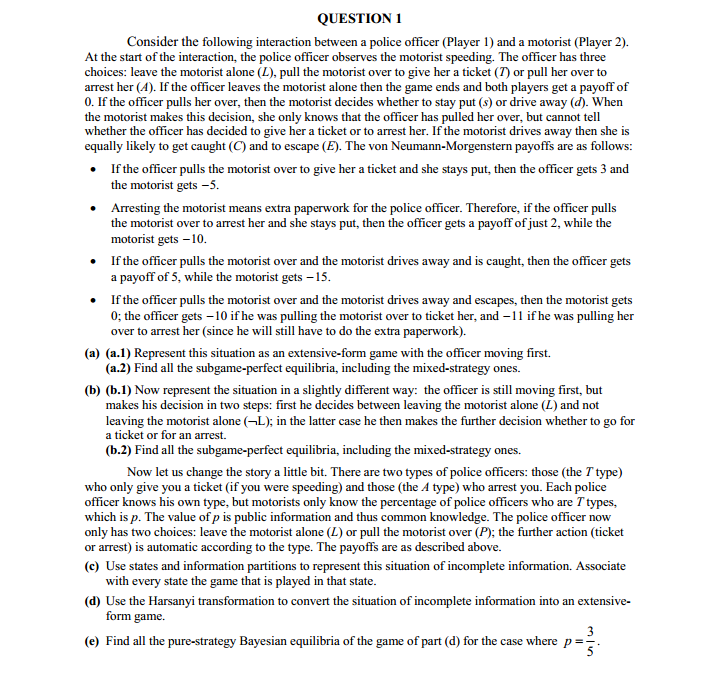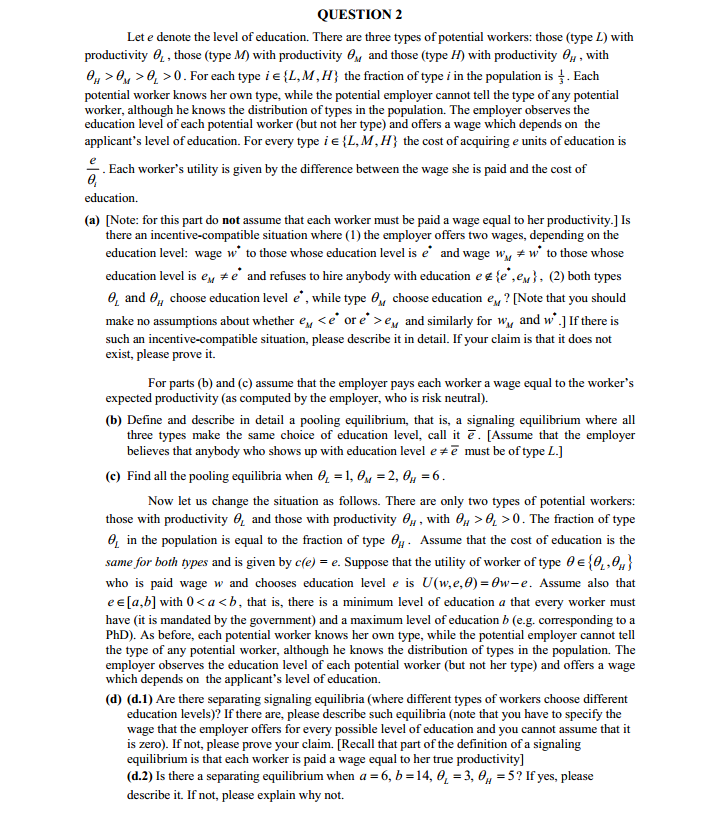

Micro201...
QUESTION 1 Consider the following interaction between a police officer (Player 1) and a motorist (Player 2). At the start of the interaction, the police officer observes the motorist speeding. The officer has three choices: leave the motorist alone (2), pull the motorist over to give her a ticket (7) or pull her over to arrest her (4). If the officer leaves the motorist alone then the game ends and both players get a payoff of 0. If the officer pulls her over, then the motorist decides whether to stay put ($) or drive away (d). When the motorist makes this decision, she only knows that the officer has pulled her over, but cannot tell whether the officer has decided to give her a ticket or to arrest her. If the motorist drives away then she is equally likely to get caught (C) and to escape (E). The von Neumann-Morgenstern payoffs are as follows: If the officer pulls the motorist over to give her a ticket and she stays put, then the officer gets 3 and the motorist gets -5. Arresting the motorist means extra paperwork for the police officer. Therefore, if the officer pulls the motorist over to arrest her and she stays put, then the officer gets a payoff of just 2, while the motorist gets -10. . If the officer pulls the motorist over and the motorist drives away and is caught, then the officer gets a payoff of 5, while the motorist gets - 15. If the officer pulls the motorist over and the motorist drives away and escapes, then the motorist gets O; the officer gets - 10 if he was pulling the motorist over to ticket her, and -11 if he was pulling her over to arrest her (since he will still have to do the extra paperwork). (a) (a.1) Represent this situation as an extensive-form game with the officer moving first. (a.2) Find all the subgame-perfect equilibria, including the mixed-strategy ones. (b) (b.1) Now represent the situation in a slightly different way: the officer is still moving first, but makes his decision in two steps: first he decides between leaving the motorist alone (2) and not leaving the motorist alone (-L); in the latter case he then makes the further decision whether to go for a ticket or for an arrest. (b.2) Find all the subgame-perfect equilibria, including the mixed-strategy ones. Now let us change the story a little bit. There are two types of police officers: those (the type) who only give you a ticket (if you were speeding) and those (the A type) who arrest you. Each police officer knows his own type, but motorists only know the percentage of police officers who are types, which is p. The value of p is public information and thus common knowledge. The police officer now only has two choices: leave the motorist alone (2) or pull the motorist over (P); the further action (ticket or arrest) is automatic according to the type. The payoffs are as described above. (c) Use states and information partitions to represent this situation of incomplete information. Associate with every state the game that is played in that state. (d) Use the Harsanyi transformation to convert the situation of incomplete information into an extensive- form game. (e) Find all the pure-strategy Bayesian equilibria of the game of part (d) for the case where p =QUESTION 2 Let e denote the level of education. There are three types of potential workers: those (type _) with productivity @, , those (type M) with productivity , and those (type #) with productivity ey , with OH > 0, > 0, >0. For each type i { L, M, H; the fraction of type i in the population is } . Each potential worker knows her own type, while the potential employer cannot tell the type of any potential worker, although he knows the distribution of types in the population. The employer observes the education level of each potential worker (but not her type) and offers a wage which depends on the applicant's level of education. For every type ic {L, M, H) the cost of acquiring e units of education is . Each worker's utility is given by the difference between the wage she is paid and the cost of education. (a) [Note: for this part do not assume that each worker must be paid a wage equal to her productivity.] Is there an incentive-compatible situation where (1) the employer offers two wages, depending on the education level: wage w to those whose education level is e and wage wy # w to those whose education level is ey # e and refuses to hire anybody with education egle ,ey}, (2) both types 0, and ey choose education level e , while type , choose education ey ? [Note that you should make no assumptions about whether ey,
ey and similarly for wy and w .] If there is such an incentive-compatible situation, please describe it in detail. If your claim is that it does not exist, please prove it. For parts (b) and (c) assume that the employer pays each worker a wage equal to the worker's expected productivity (as computed by the employer, who is risk neutral). (b) Define and describe in detail a pooling equilibrium, that is, a signaling equilibrium where all three types make the same choice of education level, call it 2. [Assume that the employer believes that anybody who shows up with education level ex e must be of type L.] (c) Find all the pooling equilibria when 0, =1, OM =2, 0g =6. Now let us change the situation as follows. There are only two types of potential workers: those with productivity , and those with productivity Oy , with Oy > 0, > 0. The fraction of type Or in the population is equal to the fraction of type By . Assume that the cost of education is the same for both types and is given by c(e) = e. Suppose that the utility of worker of type de (0, , , } who is paid wage w and chooses education level e is U(w,e, 0) =0w-e. Assume also that ee[a,b] with 0










